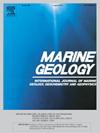Falkland/Malvinas Trough: Indications for Cenozoic tectonic and oceanographic evolution in the southwestern South Atlantic
IF 2.2
3区 地球科学
Q2 GEOSCIENCES, MULTIDISCIPLINARY
引用次数: 0
Abstract
The Falkland/Malvinas Trough (F/MT) bounds the southern extremity of the Falkland/Malvinas Plateau. This Cenozoic bathymetric depression developed as the orogenic foreland basin of the North Scotia Ridge. The sedimentary infill of the F/MT carries a history of development in a transpressional setting along the South American-Scotian Plate boundary, in association with the evolution of the Drake Passage-Scotia Sea zone. Since the F/MT is located on the pathway of the Antarctic Circumpolar Current, the current-controlled depositional and erosional features within its sedimentary infill provide valuable information on the palaeoceanographic modifications in the southwestern South Atlantic. Via a set of 2D high-resolution seismic reflection data, the structural and morphological features of these strata are investigated and discussed with respect to the tectonic evolution of the Drake Passage-Scotia Sea zone. Evidence of fold structures and normal faulting during Oligocene to mid-Miocene times in the study area argue for a transpressional regime linked with the development of the Drake Passage-Scotia Sea zone. The current-related depositional and erosional processes in the F/MT started between Oligocene to early Miocene times. With the full opening of the Drake Passage, the evolution of the Scotia Sea and the demise of the Ancestral South Sandwich Arc by the mid-Miocene, an oceanographic setting analogous to the present would have established. Evidences suggests that since then, with the enhancement of the abyssal circulation subsequent to the perennial Antarctic glaciation, a precursor of the Weddell Sea Deep Water has been circulating the F/MT, shaping a confined sediment drift deposit.
福克兰/马尔维纳斯海槽:南大西洋西南部新生代构造和海洋演化的标志
福克兰/马尔维纳斯海槽(F/MT)位于福克兰/马尔维纳斯高原的南端。新生代等深坳陷发育为北斯科舍脊造山前陆盆地。F/MT的沉积充填具有沿南美-斯科舍板块边界的跨洋背景的发展史,与德雷克通道-斯科舍海带的演化有关。由于F/MT位于南极绕极流路径上,其沉积填充物中受洋流控制的沉积和侵蚀特征为南大西洋西南部的古海洋学变化提供了有价值的信息。通过一组二维高分辨率地震反射资料,从德雷克通道-斯科舍海带构造演化的角度,研究了这些地层的结构和形态特征。渐新世至中新世中期的褶皱构造和正断裂的证据表明,研究区与德雷克海峡-斯科舍海带的发育有关。在渐新世至中新世早期,F/MT与洋流有关的沉积和侵蚀过程开始。随着德雷克海峡的完全开放,斯科舍海的演变和祖先南桑威奇弧在中新世中期的消亡,一个类似于现在的海洋环境将建立起来。有证据表明,从那时起,随着南极多年生冰期后深海环流的增强,威德尔海深水的前兆一直在环流F/MT,形成了一个封闭的沉积物漂移沉积物。
本文章由计算机程序翻译,如有差异,请以英文原文为准。
求助全文
约1分钟内获得全文
求助全文
来源期刊

Marine Geology
地学-地球科学综合
CiteScore
6.10
自引率
6.90%
发文量
175
审稿时长
21.9 weeks
期刊介绍:
Marine Geology is the premier international journal on marine geological processes in the broadest sense. We seek papers that are comprehensive, interdisciplinary and synthetic that will be lasting contributions to the field. Although most papers are based on regional studies, they must demonstrate new findings of international significance. We accept papers on subjects as diverse as seafloor hydrothermal systems, beach dynamics, early diagenesis, microbiological studies in sediments, palaeoclimate studies and geophysical studies of the seabed. We encourage papers that address emerging new fields, for example the influence of anthropogenic processes on coastal/marine geology and coastal/marine geoarchaeology. We insist that the papers are concerned with the marine realm and that they deal with geology: with rocks, sediments, and physical and chemical processes affecting them. Papers should address scientific hypotheses: highly descriptive data compilations or papers that deal only with marine management and risk assessment should be submitted to other journals. Papers on laboratory or modelling studies must demonstrate direct relevance to marine processes or deposits. The primary criteria for acceptance of papers is that the science is of high quality, novel, significant, and of broad international interest.
 求助内容:
求助内容: 应助结果提醒方式:
应助结果提醒方式:


